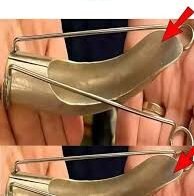A wonderful and iconic kitchen tool. That vintage-style squeezer is known by a few names, most commonly a “reamer” or a “glass lemon squeezer.”
Here’s a detailed look at this classic piece, from its history to how to use and find one.
The Vintage Glass Lemon Squeezer (or Reamer)
This tool is a symbol of a bygone era of kitchenware, prized for its simplicity, effectiveness, and beautiful design.
Key Characteristics & Anatomy:
-
Material: Typically made from clear or milk glass (opaque white), but also found in vibrant Depression glass colors like green, pink, amber, or cobalt blue. The most sought-after versions are from brands like Fire-King or Jeannette Glass.
-
Design: It consists of two main parts:
-
The Base: A round, lipped bowl with a spout and a built-in ridged reamer in the center. The reamer is a conical piece with deep grooves designed to shred the fruit’s pulp and extract every last drop of juice.
-
The Lid/Dome: A matching glass dome that fits over the base. Its primary function is to act as a splash guard, preventing juice and seeds from spraying out while you press and twist the fruit.
-
What It Was Used For:
While designed for lemons and limes, its simple design made it useful for any small, soft citrus fruit:
-
Lemons
-
Limes
-
Small oranges (like clementines or tangerines)
-
Calamansi
-
Even for juicing pomegranate halves for a small amount of juice.
How to Use It (Step-by-Step)
-
Prepare the Fruit: Cut your lemon or lime in half crosswise.
-
Place on Reamer: Take one half and place it cut-side down onto the ridged reamer in the base.
-
Cover and Press: Place the glass dome over the fruit and base. Using the palm of your hand, press down firmly on the dome while twisting the fruit back and forth.
-
Collect the Juice: The juice (and seeds) will be collected in the base. The seeds are trapped by the pulp, and the spout allows for clean, drip-free pouring.
Why People Still Love Them
-
Nostalgia & Aesthetics: They are beautiful objects that add a touch of vintage charm to any kitchen.
-
Durability: Unlike plastic, these glass squeezers are sturdy and don’t absorb stains or odors.
-
Effectiveness: They are surprisingly efficient at extracting juice, often rivaling modern metal squeezers.
-
Collectibility: Their variety of colors and brands make them a popular item for glassware collectors.
If You’re Looking to Buy One:
These are commonly found in second-hand shops, at flea markets, and on online auction sites.
Search Terms to Use:
-
Vintage Glass Lemon Squeezer
-
Fire-King Juicer / Reamer
-
Depression Glass Juice Extractor
-
Glass Citrus Juicer with Dome
-
Jeannette Glass Lemon Squeezer
What to Look For (and Avoid):
-
Condition: Check for chips, cracks, or hairlines (fine cracks), especially on the rim of the base and the tip of the reamer. These can compromise the structural integrity.
-
Completeness: Ensure the dome is present and matches the base.
-
Stains: Cloudy mineral stains are common but can often be cleaned with a vinegar soak.
With a little hunting, you can find a beautiful and fully functional piece of kitchen history. They are a joy to use and a lovely connection to the past.
